This is probably my final solar eclipse set up.
Pentax HD PENTAX D FA 150-450mm f/4.5-5.6 DC AW mounted on a Zeikos 77" 3-Section Heavy-Duty Aluminum Tripod with 3-Way Pan Head. On the front of the lens is Cokin Z-Pro Series 100mm Filter Holder with the LEE Filters 100x100mm Solar Eclipse Filter. The camera is a Pentax K5 attached via the HDMI port out to a Lilliput 7" Field Monitor mounted on a Sirui T-025x Travel Tripod positioned near the lens tripod. 2-foot cable release and shake reduction turned off. I did not use mirror lockup as it seemed to be steady enough without it and would be one more thing to screw up when I switched in totality to bracket exposures.
I experimented with multiple different setups before I came to this final set up. The following are some of the things Iíve tried:
Crossed polarizers. Crossed polarizers can be used as a variable (kind of like a neutral density) filter. The problems that led to this being rejected were, not nearly enough stops of filtering and a blue tint that was almost impossible to get rid of.
Stacked neutral density filters. With my 3 darkest neutral density filters I could get up to about 16 stops. This was minimally adequate but still, has several significant limitations. The 1st being 16 stops is near the minimum needed. It still makes it very hard to not only focus but totally washes out live view. This is also not adequate (as in not safe) to use the optical viewfinder. Stacking the filters also resulted in image degradation.
Trying to use the live view on the back of the camera was very difficult as you are facing into the sun. Even if you had an articulated screen it would still be very difficult as you want the tripod to be lower and it is still very awkward to view. Additionally, live view from the screen on the back of the camera eats up battery power extremely quickly.
Trying to mount the field monitor any place on the tripod that the lens was mounted on was very awkward and difficult. Essentially wherever I would try to mount it would always seem to get in the way. Mounting the field monitor onto the camera no matter which method I seem to use (tried several from mounting on top of the camera to using an additional bracket) was also awkward and caused additional problems that every time I would move the lens would also require a change in the field monitor. Also, the field monitor was too close to really view it while trying to move the lens-camera combination. Mounting the field monitor on a small tripod near the larger tripod worked much better and also reduced any wind sail affects/vibrations that the field monitor would produce onto the lens tripod.
Using the LEE Filters 100x100mm Solar Eclipse Filter was nearly ideal. This filter produces 20 stops of filtering. This allowed the lens to be stopped down to only f/5.6 at 450 mm with a shutter speed of 1/180 and ISO of 80. This produced an excellent exposure. I was able to photograph very small sunspots that were clear enough to make out and were approaching only a few pixels across.
Using the Cokin Z-Pro Series Filter Holder allows the filter pack to be taken off quickly and smoothly during totality. It can also be placed back on just as quickly and easily. The Lee solar filter also had an additional feature to the filter that helped with this. Around the backside of the filter on the edges is a little black foam gasket. This not only keeps out any stray light from the edges but also helps act like a little bit of a spring. The Cokin Filter Holder has a little bit of a spring action to it but this is mainly to hold the various filters snugly. Once you tighten up the screws there is very little additional spring action.
Some observations:
The Lee solar filter will get quite warm to the touch even in the anemic Northwest morning sun. I do not believe this will in and of itself hurt the filter but if youíre not aware you could be surprised and accidentally drop the filter when you pull it out of the filter holder pack. Additionally, it would probably not be wise to set it on a very cool surface until it has a chance to cool off.
Even with 20 stops of filtering the sun is so bright that there is still detectable reflective flair. This could be from 2 possible sources. The 1st being reflection of the front of the lens to the back of the solar filter and back in. As Pentax has put some of their best coatings on this lens I do not believe that this is the most likely source of the flair.
The next likely source for this a reflection is off the sensor to the back of the lens and back into the sensor. As even with these 20 stops the live view is still overexposed, I believe this is most likely the source of the flair. What this means is that it is best (in my opinion) to not shoot absolutely center of the frame. If all of the sun circle is off to the side of the center then the reflection will appear on the opposite side. This means that it will not only not interfere with the direct exposure but being off to the side can be dealt easily in PP if necessary.
With 20 stops of filtering, you may feel that you could use the optical viewfinder. Lee recommends against this and I concur. You might be able to get away with this for a few seconds but you wonít be doing this for just a few seconds. You will have to do this repeatedly for upwards of an hour. 20 stops are just not enough for this. Additionally, there still might be some leakage of ultraviolet light which you wouldnít detect until it has damaged your eyes.
With this set up with shutter speeds of 1/180 or 1/250 exposures appear to be very good. Exposures of 1/125 and 1/90 also appeared to be good and did not give any blinking warnings in the live view. Reviewing these later on the computer I could see that they had at least one blown color channel. Even one blown color channel will make it next to impossible to set your white balance lie for white. Additionally, you want a little bit of head room for later PP adjustments of things like contrast and brightness. So itís definitely better (if not imperative) to be a little underexposed.
I did consider going with a longer focal length than 450 mm. Early on I did experiment with an X1.4 and a 500 mm lens but concluded that the field-of-view was just too narrow on APS-C. It is too hard to keep the sun in the frame all the time and more difficult to have it off to the side and still in the frame (see above). Additionally, in totality, you probably will want to see much more around the sun so 450 mm appears to be about ideal.
When I mounted the lens on the tripod I found it worked much better to have the elevation handle forward. This not only kept it out of coming in contact with the center pole (in fact I didnít have to raise the center pole thus increasing stability) but I found I had much more leverage. Having a three-way pan head was also much better than a ball head. I could much easier control one thing at a time instead of having to control all of them simultaneously. This was very important as you needed to continuously track the sun.
Having the field monitor on its own tripod allowed both tripods to be set very much lower and more stable. They were also easier to handle and you could sit in your chair and watch the monitor. One word about this. Is probably best not only from the point of view of batteries (for both the field monitor and the camera) to stay in live view continuously. Normally there is a limit of approximately 10 to 15 minutes before the sensor starts to heat up in the camera wants to shut itself down. Even though most of the heat is attenuated by the solar filter is probably getting more heat than normal which probably exasperates this problem. I do not believe that this will necessarily harm the sensor but you might be stuck having to wait for the camera to cool down at a critical time. With this in mind, it is probably better to set yourself up on a schedule of on and off (say 5 minutes on 5 minutes off for example).
LEE Filters 100x100mm Solar Eclipse Filter
Pentax HD PENTAX D FA 150-450mm f/4.5-5.6 DC AW
Pentax K5.
Zeikos 77" 3-Section Heavy-Duty Aluminum Photo & Video Tripod with 3-Way Pan Head
Sirui T-025x Travel Tripod
Cokin Z-Pro Series Filter Holder
Lilliput 7" Field Monitor
Linked below is the camera set up and an example full frame full resolution sun photo. Seeing was fair to good. There were a few high thin clouds in the area that I had to wait to pass but there was also forming a thin overall layer. This is why the seeing was only fair to good.
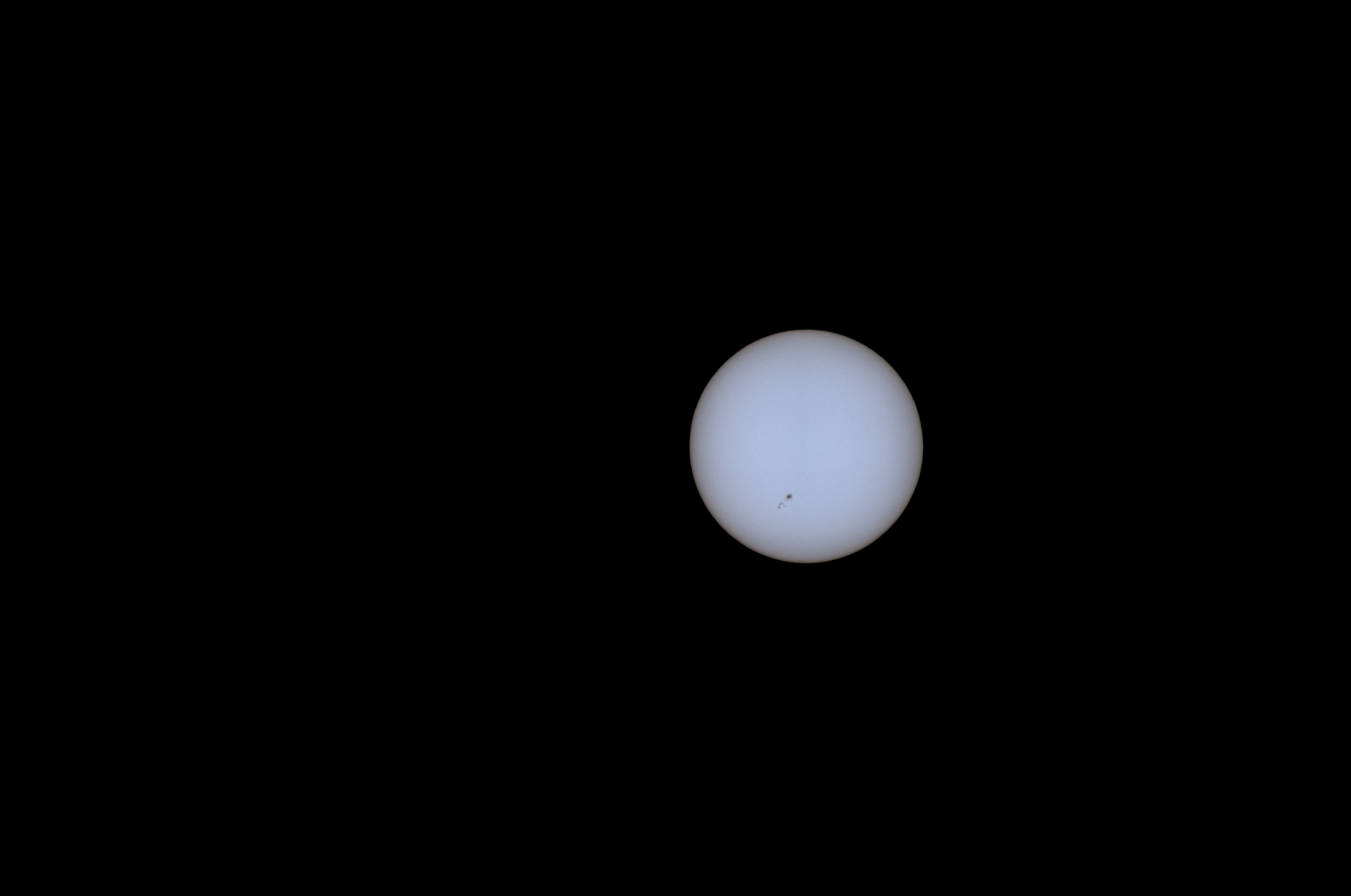
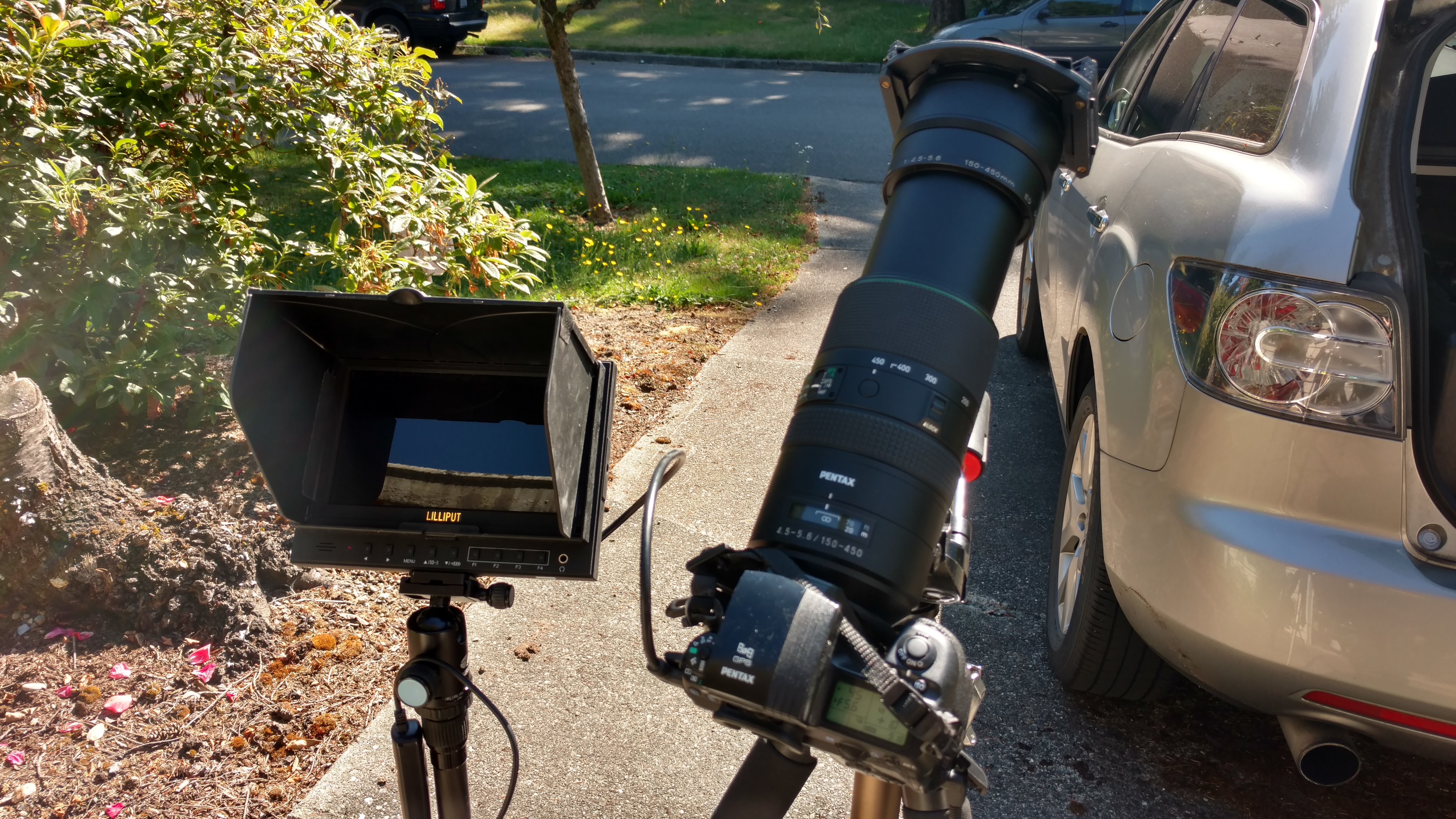
DAZ


 Similar Threads
Similar Threads 





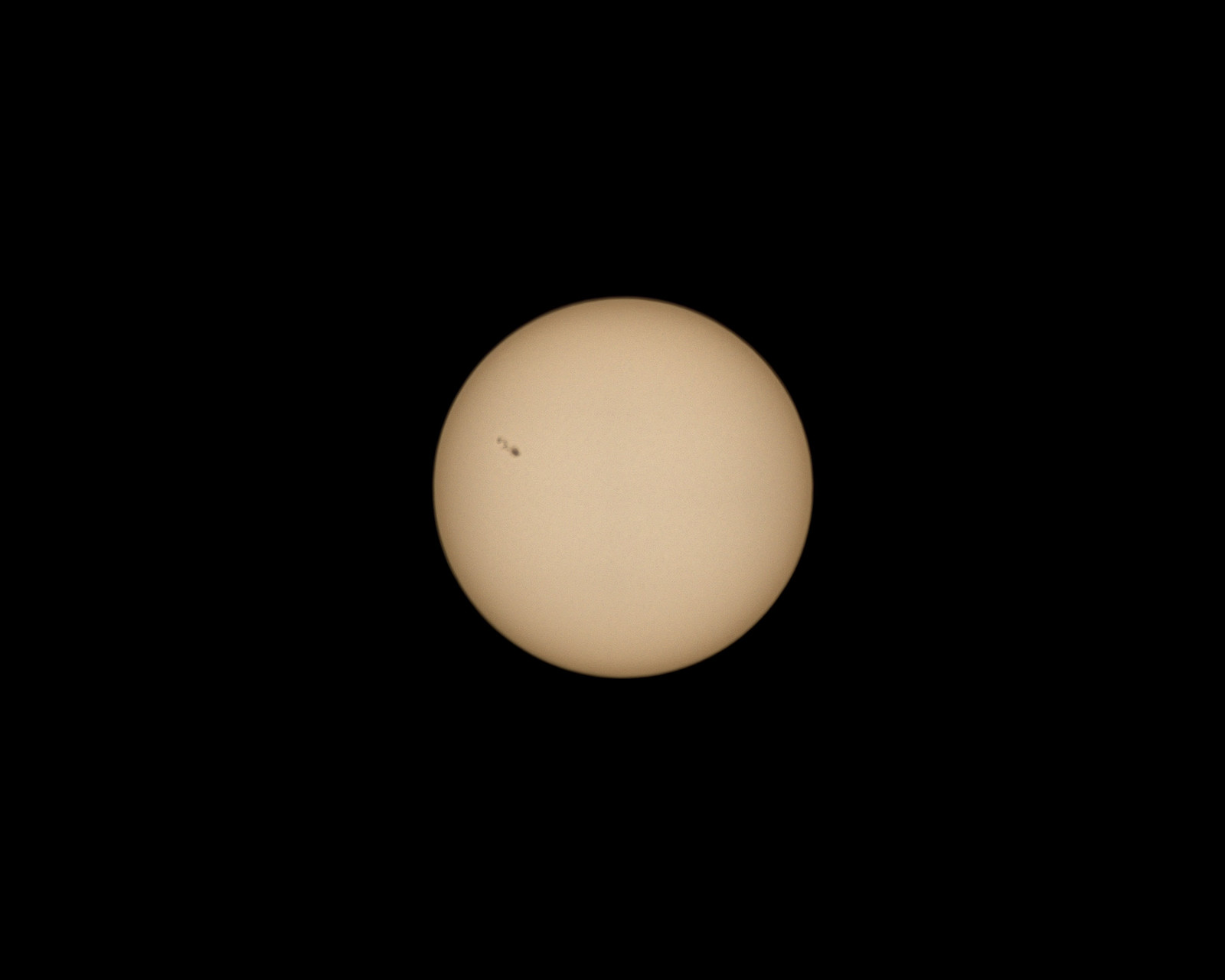



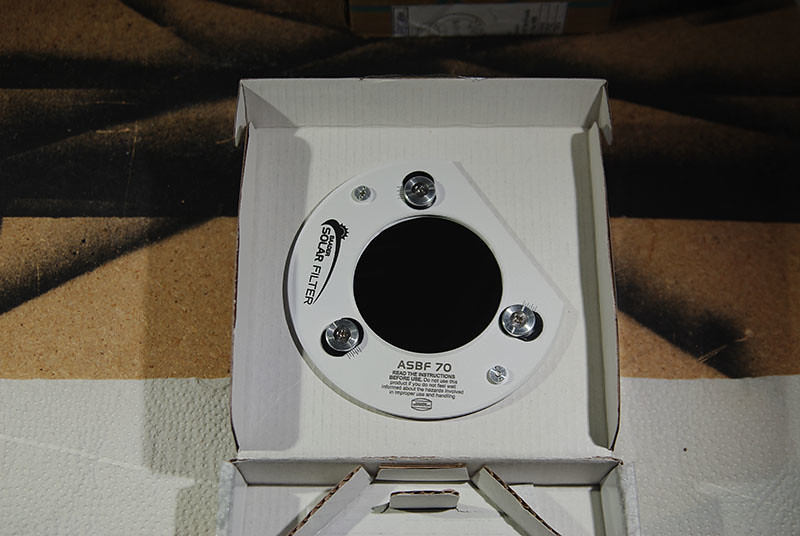
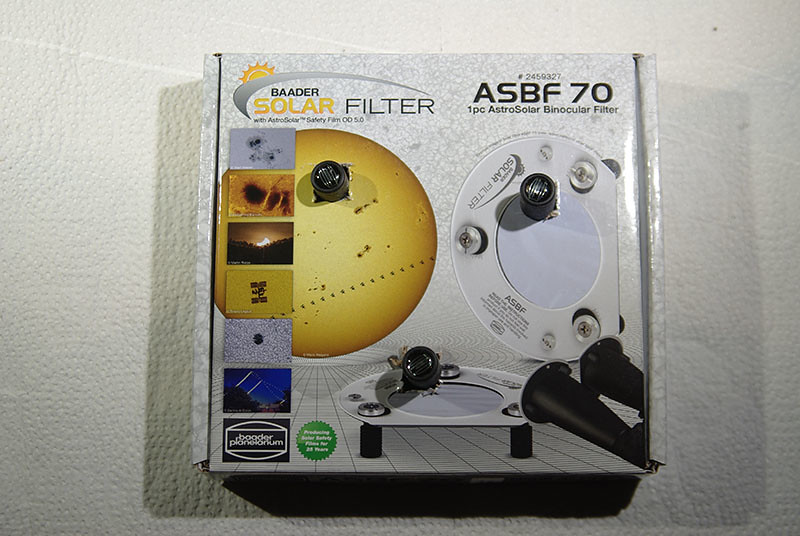










 Post #1 by AstroDave
Post #1 by AstroDave








